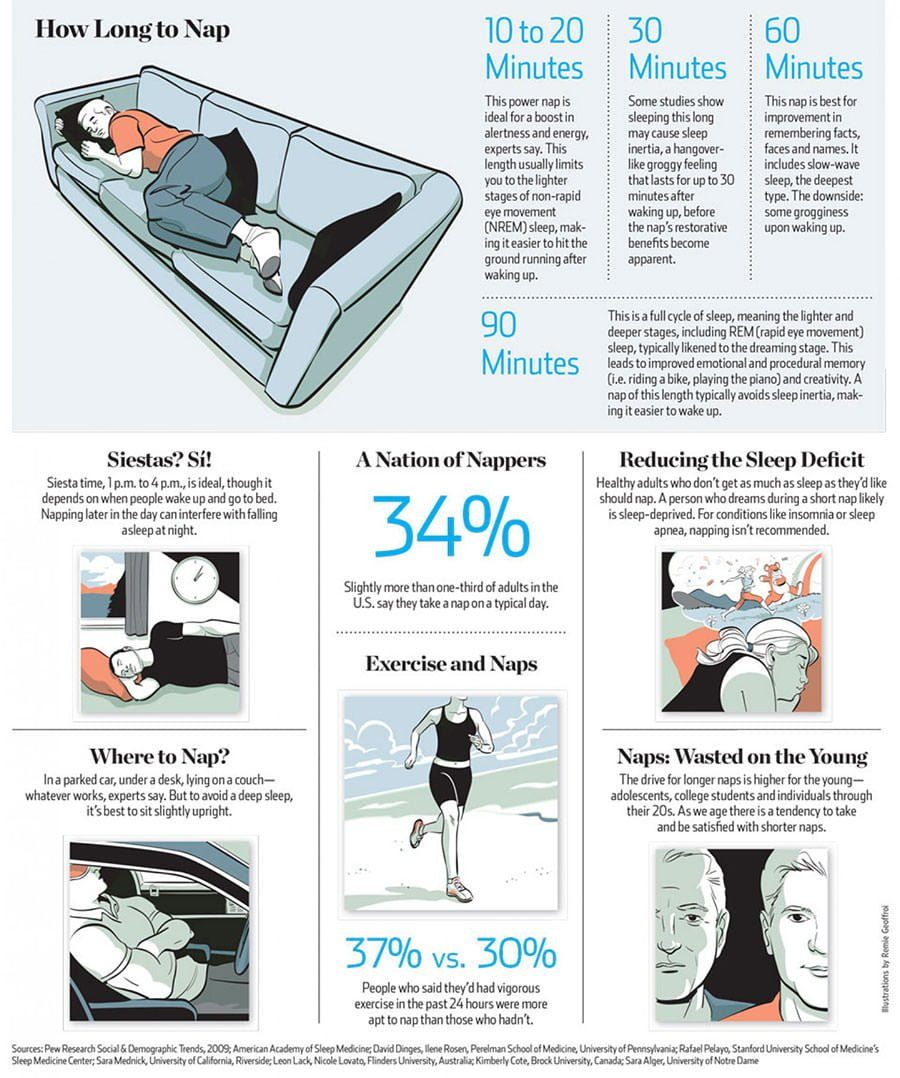What’s the best way wake up our brains and get over that feeling of fatigue and exhaustion? Taking a nap improves brain activation and improves our level of alertness, memory, sense of humor, and creativity. Is there a “perfect” nap? What are the main benefits of taking a nap and how can you get them? Here are 10 ways to optimize your brain resources while you nap.
1. Napping helps fight mental exhaustion
Many people associate physical exhaustion with wanting to sleep, but mental exhaustion plays an important role in our sleep rhythm. Throughout the day, our brains accumulate adenosine, a hormone that slows down brain activity and induces sleep.1✅ JOURNAL REFERENCE
DOI: 10.1016/S0074-7742(05)63007-3 So having a nap is a perfect opportunity to recharge your energy reserve (glycogen) and bring these levels back down.
What to do: Don’t wait until you are exhausted to have a nap. Sleep 15 minutes for every 2-3 hours of activity. You can also sleep for 2 hours for every 9-10 hours of alertness. However, it’s better to take a nap before feeling tired, rather than after you already feel tired.
2. Napping can help increase brain activity
Taking a 10 or 15 minute nap helps recover your attention level for at least 3-4 hours.2✅ JOURNAL REFERENCE
PMID: 12220317 However, the way you sleep is very important. Aside from hormones, scientists can see how your brain is functioning through its electrical activity (EEG). For example, attention levels and alertness is about P300 electrical waves. The monotony of daily life can make these “attention waves” decrease.
What to do: According to studies, the classic horizontal posture (lying down), is the best way to recover and restore your alertness. Other postures, like leaning over your knees or lying on a chair bring varying levels of satisfaction, but have actual physiological effects.
2. Napping can be a healthy habit
If you’re one of those people who regularly takes naps (2-3 times a week), you’re pretty lucky. Taking naps definitely has benefits for our brains and our bodies. It’s a healthy habit that can help lower blood pressure, strengthen the immune system, avoid fatigue, increase motivation, and improve mood.3✅ JOURNAL REFERENCE
PMID: 21359666 4✅ JOURNAL REFERENCE
DOI: 10.1093/aje/kwu036
What to do: The best time to take a nap is mid-day, when your active levels are running low. Set up a quiet room with a bed, and shut out as much light as possible. Make sure the room is a comfortable temperature, and prepare to sleep just 10-15 minutes. This should be enough time to restore your energy levels and prepare you for the rest of the day.
3. Napping helps your brain recover after intense mental activity
Our brain is best able to rest during deep sleep, which happens after sleeping about 25 minutes. It is a period to disconnect, where your neural activity and blood flow to the brain decreases. If you’ve spent hours working or studying, your brain needs extra time to recover.
What to do: You don’t need to sleep longer if the activity you were doing was especially intense (like studying for a test), but you should give it the 10-20 minute rest it needs to recover.
4. Napping helps strengthen your memory
How can napping help you remember what you’ve just studied? Naps that activate deep sleep or help you integrate and remember the information that you’ve studied, but the length of the nap does make a difference.5✅ JOURNAL REFERENCE
PMID: 23301831
What to do: Adjust your nap to the activity. For example, to remember information that you’ve just read, you’ll probably be fine with just 23-30 minutes. However, if you’ve been memorizing information, you’ll need a deeper sleep to be able to “record” the information.
5. Napping can help reduce stress
That’s right. A study has shown that napping seems to be a perfect “antidote” to counteract stress that you’ve accumulated throughout the day.6✅ JOURNAL REFERENCE
DOI: 10.1016/j.annemergmed.2006.02.005 During the first 15 minutes of sleep, the neurons in the prefrontal cortex (for executive functions), start to “relax”.
What to do: If your job is stressful and requires a lot of attention, like doctors or pilots, try to take a 20 minute nap mid-day.
6. Trust your brain while you sleep: your brain knows how to prioritize
Imagine that there are two types of news: one that is emotional (“your house just burned down”) and another academic one (“memorise this text after a nap”). While you sleep, your brain will “record” the information about the exam. Why? Because it’s able to prioritize what’s most important to your near future.7✅ JOURNAL REFERENCE
PMID: 25706830
What to do: In a lucid sleep, you’re semi-able to control what you dream about. You can program yourself to take a nap and think about your goal. However, this takes practice to achieve!
7. Napping can help make you happier
We’ve seen how naps can make you less tired and improve memory and performance, but what happens to our emotions? Taking naps can increase the number of positive emotions that you feel, you’ll have more energy, and you’ll be motivated by your sense of happiness.8✅ JOURNAL REFERENCE
PMID: 10210616
What to do: Taking a short 15 minute nap can improve your mood. You’ll get away from what’s happening in the world and improve your mood.
8. Napping can give your brain function a quick boost
Even just a short 6-7 nap after reading a text can help improve your brain function.
What to do: If you’re feeling tired or have little energy, take an express nap! Take advantage of that comfy library and close your eyes for a quick nap.

